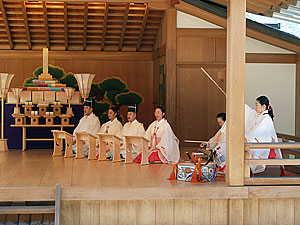In Kumamoto, it’s all about water – and fire
By Bill Roberts
I will always remember Kumamoto for the water. Located in central Kyushu Island, the Kumamoto area has an aquifer which courses through ancient lava beds from Mount Aso, an active volcano, producing some of the purest, coldest water in Japan.
Whatever destruction Mount Aso’s eruptions might have caused over the millennia, the volcano’s gift are the lava beds that filter the water into a pure essence and help nurture the region’s fertile valleys.
The Kumamoto branch, which sits on a spit of land overlooking rice paddies and other crops, about thirty kilometers from downtown Kumamoto City, makes the best possible use of the local water.
Two beautiful ponds dominate the branch’s garden, which was full of hydrangeas in blossom when I visited for the monthly service in late June 2007, one of five branch visits that summer.
The Kumamoto branch has more area than most Oomoto branches. On the front of the property sits a large pond with a mound behind it representing Mount Fuji.
Mount Fuji is sacred to Oomoto followers. The Spiritual Leader and many Oomoto members made a pilgrimage to the top of Fuji in the summer of 2007, just a few weeks after I visited Kumamoto. The Kumamoto model of Fuji is about two meters high, or 3,774 meters (about 12,380 feet) shorter than the real mountain. There’s a shrine at the base of Kumamoto’s Fuji.
At the back of the garden sits a larger pond, pure and serene, with many koi and a Buddha sitting on a stone in the middle. Beyond that is a statue of Izunome Kannon, a kami -- god -- with an interesting history; more about it in a minute.
Two outdoor prayers
After the ritual inside the shrine, the branch holds two prayers outside. The first is held in front of Izunome Kannon. The second prayer is held at the shrine at the base of Fuji. After that, we return inside the building for the sacred lunch, called naorai.
The day after the Kumamoto Tsukinamisai, Eiji Kino, the branch chief, took us on a sightseeing tour. The color green barely begins to describe this lush corner of Japan, which has rugged hills surrounded by rich farmland. Besides the many rice paddies and vegetable plots, there are many fields of tobacco, an important cash crop.
The highlight of our tour was a stop at the base of Miroku Iwa, which had tobacco fields spread in front of it. Miroku Iwa figures in "Reikai Monogatari" ("Stories from the Spiritual World"), written by Onisaburo Deguchi, the Co-Founder of Oomoto.
During his travels in the spiritual world, which are the basis for his 81-volume "Reikai Monogatari," Onisaburo saw a rock in the Rocky Mountains of North America. Years later, he saw a photo of this same rock in Kumamoto – Miroku Iwa -- and immediately recognized it as the one from his travels in the spiritual world in 1898.
According to Oomoto mythology, as told by Onisaburo, an angel created this rock in North America. How it came to stand in Kumamoto is not explained. But Onisaburo was clear that this was the same rock.
Later, when he visited in person, he wrote five tanka poems about it. The gist of one of these poems was this: “I am very happy to see this rock which I have longed to see again for a long time.” His wife, Sumiko Deguchi, the Second Spiritual Leader, declared that the face of Miroku Iwa to be the face of the supreme god, or Miroku.
The story of Izunome Kannon
There’s a small shrine across the road that runs in front of the rock. And from that shrine you can see the rock above. Right next to the shrine is another version of the Izunome Kannon. Izunome Kannon has an interesting history.
The statue near the base of Miroku Iwa arrived in Kumamoto by boat in the early nineteenth century. The boat captain had orders to deliver it to Kumamoto, but did not know who had built it or to whom he was to deliver it. So, the villagers took it and put it in a prominent place where they would visit to pray, not knowing who sent it or why.
In 1923, when Onisaburo visited the area to see Miroku Iwa, he also discovered this statue. When he stood next to it, he found it to be exactly his height from head to foot. He proclaimed it to be “Izunome Kannon.”
The statue was filthy when Onisaburo saw it, so he enjoined the local members to keep it clean. And so they have for 95 years. Oomoto eventually acquired the Izunome Kannon and the land near the base of Miroku Iwa.
The second Izunome Kannon, on the grounds of the branch shrine several kilometers from Miroku Iwa, was sculpted by an Oomoto follower and placed on the branch site in 1929.
Kannon is the Japanese name for the Buddhist bodhisattva of compassion, known in Chinese as Kuan-yin and in Sanskrit as Avalokiteshvara. The bodhisattva is female and widely associated with childbirth.
“Izunome” was the distinctive name that Onisaburo gave this particular Kannon near the base of the rock. Izunome is a reference to the Oomoto teaching that Onisaburo and Foundress Nao Deguchi were the spiritual polar opposites necessary to lead the work of reconstructing the world: fire (izu) and water (me, a shorten version of mizu). The warp and weft of weaving is also an analogy in Oomoto’s writings used to describe their relationship.
The Buddhist Kannon has also been appropriated by other Shinto sects. To understand this, it is useful to note that throughout the mostly peaceful coexistence of Buddhism, which came to Japan about 1,400 years ago, and of the traditional practices known as Shinto, the two religions have evolved together, influencing each other in many ways. Over time, many Buddhist bodhisattvas came to be recognized as Shinto kami, and many kami were recognized as bodhisattvas.
For Oomoto, the Izunome Kannon has the additional trait of representing the spirits of Nao and Onisaburo.
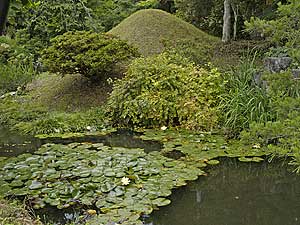
In the Kumamoto branch garden, a model of Mount Fuji.
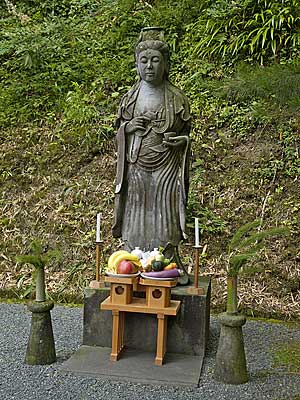
At the back of the garden, a statue of Izunome Kannon.
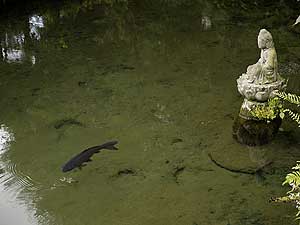
The second and larger pond in the garden.
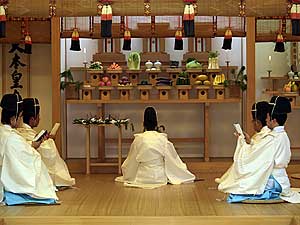
Prayer inside the shrine at the monthly service.
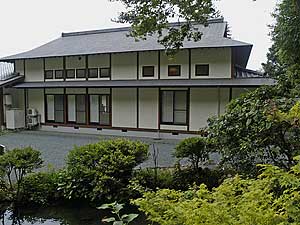
The Kumamoto branch shrine.
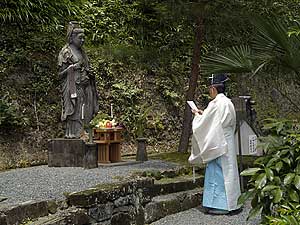
After the service inside, a prayer at the Izunome Kannon.
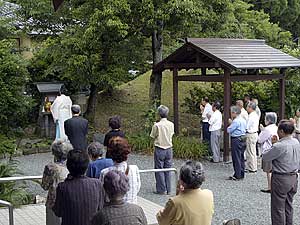
And a second outdoor prayer at Mount Fuji.
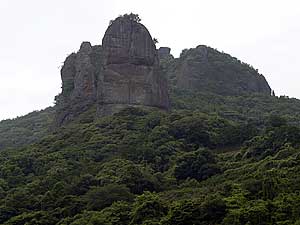
Miroku Iwa, a sacred rock featured in Onisaburo’s “Stories from the Spiritual World.”
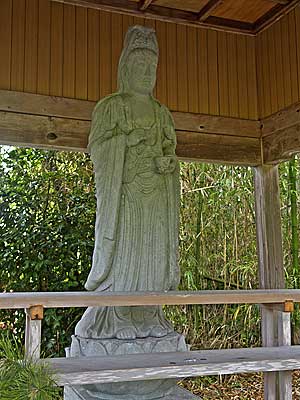
Near the base of Miroku Iwa, stands the original Izunome Kannon.
New Contents Thu, May 20, 2010
- Oomoto participates in Sant’Egidio conference : Dialogue among religions and cultures : On divided island nation of Cyprus By Bill Roberts
- Photo Album : Portraits of three branches: Shoko, Tanegashima and Aomori By Bill Roberts
- Oomoto FAQ
- A Letter from Oomoto : Of mountains and myths By Bill Roberts
- Polyglot poem festival The Utamasturi is going international — what’s next? By Bill Roberts
- Ethics education program captures the spirit of Bankyo Dokon By Bill Roberts
- A Letter from Oomoto : A year’s worth of adventure in a summer of branch visits By Bill Roberts
- In Kumamoto, it’s all about water – and fire By Bill Roberts
- A speech by Nevada Taylor at the Kii Branch in Wakayama Prefecture on April 13, 2008.:An Encounter With Oomoto Through Aikido
- Utamatsuri, Poem Festival, in Tokyo(on April 17, 2008)
- A speech by Neil Ryan Walsh at the Kobe branch on Mar. 9th, 2008.:Planting the Seeds of the Soul
- Meeting with the Fifth Spiritual Leader of Oomoto, Madame Kurenai Deguchi by Neil Ryan Walsh
- A speech by Neil Ryan Walsh at the Nagoya branch on Feb. 17th, 2008.:The Japanese Arts beyond National Boundaries
- To the Oomoto branch in Nagoya: City of Eel and Toyota by Neil Ryan Walsh
- A Speech by Nissim Ben Shitrit, Ambassador of Israel on the occasion of the Oomoto Setsubun Grand Festival in Ayabe February 3rd, 2008 : Japan and Israel : Two Lands Balancing the Needs of Traditional Culture and Modern Life. r
- A permanent memorial to Onisaburo (A Speech at the Autumn Grand Festival , November 6, 2007 : )By James Parks Morton, Founder and Chair, Emeritus of The Interfaith Center of New York
- Israel, Palestine and the Power of Poetry(Oomoto believes small efforts can have lasting ripple effects on people and peace)By Bill Roberts
- “Something Great”(This genetics pioneer, a friend of Oomoto, offers a clue to the mystery of life)By Bill Roberts
- Kamishima Cleanup (Harima branch members regularly visit this sacred island to keep the shrine tidy)By Bill Roberts
- Kyotaro Deguchi was one of six recipients of the 2007 James Parks Morton Interfaith Award
What is Oomoto?
- What is Oomoto?
- Spirtual Centers
- Founders and Spiritual Leaders
- History
- Organization and activities
- Teachings and scriptures
- Art Works of Founders and Leaders
Opinions[Archive]
- Statement of regret for the outbreak of war against Iraq (March 20,2003)
- Jinrui Aizenkai dispatched the "Urgent Appeal for a World (Global) Crisis" on March 14.
Grappling with Bioethics[Archive]
- Oomoto’s support for abolishing the death penalty (12, June 2003)
- The Oomoto Foundation protests any birth of a human clone baby. (5, January 2003)
- OOMOTO'S VIEW REGARDING JAPAN’S PERMITION TO THE RESERCH OF HUMAN EMBRYONIC STEM CELLS (ES cells)(12, June 2000)
Vistor’s Review[Archive]
- A speech by Bill Roberts at the Oomoto branch in Hiroshima after its monthly service on March 18, 2007:Encounters with war and peace
- How Bankyo Dokon changed one life by Linda Macphee
- A speech by Bill Roberts at the Hokuriku (Kanazawa) branch on Dec. 3, 2006:Ritual and myth -an encounter with ‘divine madness’
- A speech by Bill Roberts at the Himeji Cultural Center on Feb. 25, 2007:Mesmerized by the Japanese Arts
- A speech by Bill Roberts at the Kobe branch on Feb. 11th, 2007.:There are just human tears and human joy
- A Speech on the occasion of the Oomoto Setsubun Grand Festival in Ayabe February 3rd, 2007 : Egypt's role in Middle East peace
- Keynote Speech for the 28th World Federation Japanese Religionists Conference for World Peace in Tokyo (at Kokugakuin University, Novermber 29, 2006):Vision for Peace in the Middle East By Dr. Munther S. Dajani, Professor Dean, Faculty of Arts, Al Quds University, Jerusalem
- A speech to the Kyoto branch:Spiritual adventures in researching Oomoto leaders
- A Speech at The Oomoto Foundation on Monday, November 6, 2006 : Jordan's role in Middle East By Samir Nouri, Ambassador of the Hashemite Kingdom of Jordan
- A letter from Oomoto:The Young People of Tottori
- A speech by Bill Roberts on the occasion of the dedication ceremony for the new shrine of Tottori Branch By Bill Roberts Oct. 8, 2006
- A speech by Bill Roberts at the Oomoto branch in Hiroshima after its monthly service on March 18, 2007:Encounters with war and peace
- How Bankyo Dokon changed one life by Linda Macphee
- A speech at Setsubun : A Portrait of Oomoto By Bill Roberts Feb. 3, 2006
- New Publication ! By Bill Roberts Feb. 3, 2006 A Portrait of Oomoto
you can read this book in html => http://www.jinruiaizenkai.jp/English/en-kolumno/en-bill/en-sugao/billbook1en.html
E-mail below to order brobert1@ix.netcom.com
Current Topics
- Prayer Offering and World Religious Forum II
- Living the art of dialogue
- Kyotaro Deguchi was one of six recipients of the 2007 James Parks Morton Interfaith Award
Books
Online Books
- Divine Signposts by Onisaburo DEGUCHI
- The Creation of Meaning by Hidemaru Deguchi
- Bankyo Dokon(Seventy years of Inter-Religious Activity at Oomoto)
- Nao Deguchi — A Biography of the Foundress of Oomoto
- The Great Onisaburo Deguchi published by Aiki News
- Bankyo Dokon Seventy Years of Inter-Religious Activity at Oomoto
- Insearch of Meaning
- Nao Deguchi A Biography of the Foundress of Oomoto
- A Portrait of Oomoto By Bill Roberts
Oomoto international Archive
- The History of Oomoto (Jan.– Mar. 1980 — Apr.– Jun. 1982)
- The Ancestors; Friends or Foes? (Apr.– Jun. 1987)
- Tsukinamisai; The Sabbath of Shinto (Jan.– Jun. 1983)
- The Poem Festival at Oomoto; An Ancient Rite Lives Again (Oct.– Dec. 1981)
- Purification of the Universe ; Oomoto's Setsubun Festival (Apr.– Jun. 1981)
Links
Flowers at Ten'on-kyo & Baisho-en (photographs)
Contact
All rights reserved : the Oomoto Foundation Produced by the Netinformational Commission
Since : Mar. 7.1998 Last Update : Thu, May 20, 2010
E-mail : webmaster@oomoto.or.jp
Top Page Nihongo Esperanto Português Roomazi



